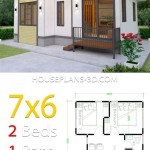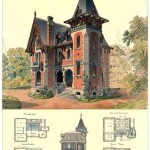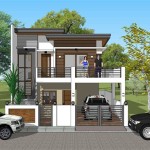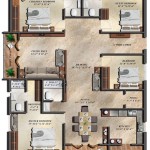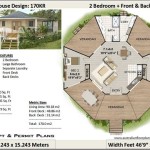Two-Bedroom Flat Plan With Dimensions: A Comprehensive Guide
The two-bedroom flat plan is a common and versatile housing option, suitable for individuals, couples, small families, and even shared living arrangements. Understanding the dimensions and spatial layout of such a plan is crucial for effective space planning, furniture selection, and overall comfort. This article provides a detailed exploration of two-bedroom flat plans, focusing on typical dimensions, key considerations for each room, and variations in layout.
A typical two-bedroom flat generally ranges from 700 to 1200 square feet, although this can vary significantly depending on location, building type, and architectural design. The overall size and dimensions directly influence the size and configuration of each room, including the living area, kitchen, bedrooms, and bathrooms. Therefore, it is essential to carefully analyze the floor plan and dimensions before making any decisions regarding furniture, appliances, or interior design.
Key Considerations: Living Area Dimensions and Layout
The living area serves as the central hub of the flat and should be designed to accommodate various activities, such as relaxation, entertainment, and social gatherings. The dimensions of the living area significantly impact its functionality and aesthetic appeal. A living area typically ranges from 150 to 300 square feet, depending on the overall size of the flat. A rectangular or square shape is often preferred, as it allows for easier furniture arrangement. The length and width of the room should be proportional to create a balanced and visually appealing space.
When planning the layout, consider the placement of key furniture pieces, such as sofas, armchairs, coffee tables, and media consoles. Adequate circulation space should be provided to ensure comfortable movement throughout the room. The location of windows and doors also influences the furniture arrangement and natural lighting. In a smaller living area, it is crucial to prioritize functionality and minimize clutter to maximize the available space. Opting for multi-functional furniture, such as sofa beds or storage ottomans, can help to optimize space utilization.
Specific dimensions to consider include the wall space available for a television and media console, the area required for a seating arrangement, and the distance between furniture pieces for comfortable passage. For example, a typical sofa might require 7 to 9 feet of wall space, while a coffee table usually measures between 3 to 5 feet in length. Maintaining a minimum of 3 feet of clearance between furniture pieces and walls is recommended to ensure comfortable movement.
Bedroom Dimensions and Functionality
The bedrooms are designated as private spaces for rest and relaxation. The master bedroom is typically larger than the second bedroom and may include an en-suite bathroom or a walk-in closet. The dimensions of the bedrooms should be sufficient to accommodate a bed, bedside tables, a dresser, and adequate storage space. A master bedroom generally ranges from 120 to 200 square feet, while a second bedroom might range from 80 to 150 square feet.
The dimensions of the bed are a primary consideration when planning the bedroom layout. A queen-sized bed, measuring approximately 5 feet wide and 6.6 feet long, is a common choice for master bedrooms. A full-sized bed, measuring approximately 4.5 feet wide and 6.25 feet long, may be suitable for smaller bedrooms or for single occupants. Twin beds, measuring approximately 3 feet wide and 6.25 feet long, are often used in shared bedrooms or guest rooms.
In addition to the bed, the placement of bedside tables is essential for convenience and functionality. Bedside tables typically measure between 1.5 to 2 feet wide and should be positioned on either side of the bed, allowing for easy access to lamps, books, and other personal items. A dresser provides additional storage space for clothing and accessories. The dimensions of the dresser will vary depending on its size and configuration, but it is important to ensure that there is enough clearance space for opening drawers and walking around the furniture.
Closet space is another critical factor to consider. A standard closet should have a minimum depth of 24 inches to accommodate hanging clothes. The width of the closet will depend on the amount of storage required. Walk-in closets offer ample storage space but require a larger bedroom footprint. In smaller bedrooms, built-in wardrobes or wall-mounted cabinets can help to maximize storage space without taking up too much floor area.
Kitchen and Bathroom Layout
The kitchen is a functional space for food preparation and cooking. The layout and dimensions of the kitchen should be designed to optimize efficiency and convenience. Common kitchen layouts include galley kitchens, L-shaped kitchens, U-shaped kitchens, and island kitchens. The choice of layout will depend on the available space and the desired functionality. A kitchen typically ranges from 60 to 100 square feet in a two-bedroom flat.
The placement of appliances, such as the refrigerator, stove, oven, and dishwasher, is crucial for creating an efficient work triangle. The work triangle connects the sink, refrigerator, and stove, minimizing the distance between these key appliances. Ample counter space should be provided for preparing food and placing kitchen utensils. The height of the countertops should be comfortable for the user, typically around 36 inches. Sufficient storage space, including cabinets and drawers, is essential for storing cookware, dishes, and food items.
Bathrooms are typically smaller spaces, ranging from 30 to 60 square feet. The layout should accommodate a toilet, sink, shower, or bathtub. The dimensions of the fixtures will influence the overall layout. A standard toilet requires approximately 30 inches of width and 60 inches of depth. A standard bathtub measures approximately 30 inches wide and 60 inches long. A shower stall typically requires a minimum of 36 inches by 36 inches.
Adequate clearance space should be provided around each fixture to ensure comfortable movement. A minimum of 24 inches of clearance is recommended in front of the toilet and sink. Storage space, such as a vanity cabinet or wall-mounted shelves, is essential for storing toiletries and bathroom accessories. Proper ventilation is also crucial for preventing moisture buildup and mold growth.
Beyond the core rooms, it's important to consider hallways, entryways, and any balcony or outdoor space. Hallways should be wide enough to allow for comfortable passage, even when carrying items. Entryways should provide a welcoming space for guests and sufficient room for removing shoes and coats. Balconies or outdoor areas can extend the living space and provide a place for relaxation and outdoor dining. These spaces, while often smaller, contribute significantly to the overall functionality and liveability of the two-bedroom flat.
The overall dimensions of a two-bedroom flat are not the only determining factor in its suitability. Ceiling height also plays a crucial role. Low ceilings can make a space feel cramped and claustrophobic, while high ceilings can create a sense of spaciousness and airiness. A standard ceiling height is typically around 8 feet, but higher ceilings can enhance the overall aesthetic appeal and functionality of the flat. Consider whether existing or planned lighting fixtures require certain ceiling heights for optimal illumination. Adequate natural light is also important and is affected by window dimensions and placement. Large windows maximize natural light, while smaller windows might require supplementary lighting.
In conclusion, a thorough understanding of the dimensions of each room in a two-bedroom flat plan is crucial for effective space planning, furniture selection, and overall comfort. The dimensions of the living area should be carefully considered to accommodate various activities and ensure comfortable movement. The bedrooms should be designed to provide adequate space for rest and relaxation, with sufficient storage space for clothing and personal items. The kitchen and bathroom layouts should optimize efficiency and convenience. By carefully analyzing the floor plan and dimensions, it is possible to create a functional and aesthetically pleasing two-bedroom flat that meets individual needs and preferences. Understanding these spatial considerations when acquiring or renovating a two-bedroom flat can directly contribute to a more comfortable and liveable home environment.

A Two Dimensional Drawing Showing The Ground Floor Plan Of Bedroom Scientific Diagram

2 Bedroom Layout Google Search

2 Bedroom Bath 800 Sq Ft House Plans Blog Floorplans Com

2 Bedroom Adu Floor Plans Designs Layouts Exteriors

Two Bedroom Small House Design Shd 2024030 Pinoy Eplans

2 Bedroom Apartment Plan Examples

Beautiful 2 Bedroom Floor Plans With Dimension Peteroz Construction Blog

Six Low Budget Kerala Model Two Bedroom House Plans Under 500 Sq Ft

Country Porches 2 Bedroom Cottage Style House Plan 5712

Third Ward Two Bedroom Apartments Jackson Square
Related Posts

